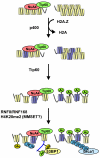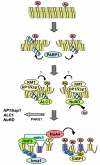Chromatin remodeling at DNA double-strand breaks
- PMID: 23498941
- PMCID: PMC3670600
- DOI: 10.1016/j.cell.2013.02.011
Chromatin remodeling at DNA double-strand breaks
Abstract
DNA double-strand breaks (DSBs) can arise from multiple sources, including exposure to ionizing radiation. The repair of DSBs involves both posttranslational modification of nucleosomes and concentration of DNA-repair proteins at the site of damage. Consequently, nucleosome packing and chromatin architecture surrounding the DSB may limit the ability of the DNA-damage response to access and repair the break. Here, we review early chromatin-based events that promote the formation of open, relaxed chromatin structures at DSBs and that allow the DNA-repair machinery to access the spatially confined region surrounding the DSB, thereby facilitating mammalian DSB repair.
Copyright © 2013 Elsevier Inc. All rights reserved.
Figures




References
-
- Ayoub N, Jeyasekharan AD, Bernal JA, Venkitaraman AR. HP1-beta mobilization promotes chromatin changes that initiate the DNA damage response. Nature. 2008;453:682–686. - PubMed
-
- Billon P, Cote J. Precise deposition of histone H2A.Z in chromatin for genome expression and maintenance. Biochimica et biophysica acta. 2012;1819:290–302. - PubMed
Publication types
MeSH terms
Substances
Grants and funding
LinkOut - more resources
Full Text Sources
Other Literature Sources

